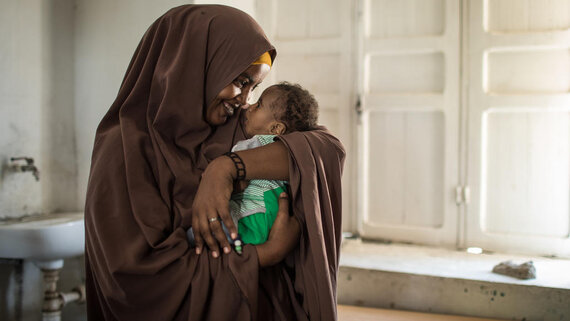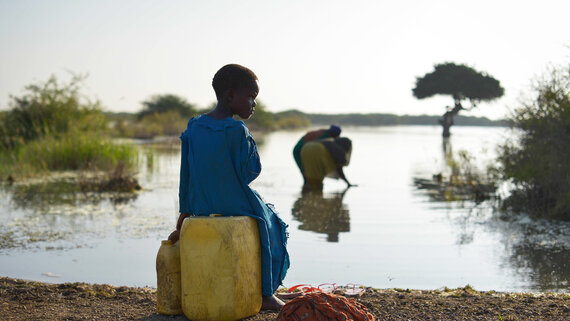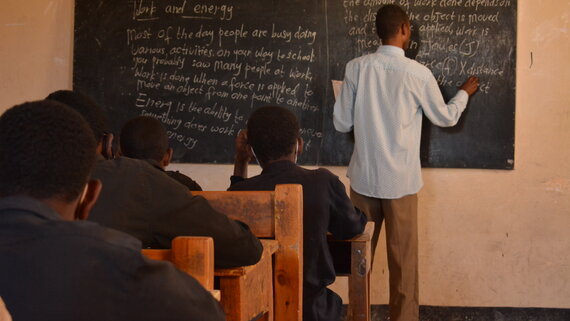Analysis of the context, crisis and needs
Despite progress in recent years, conflict, recurrent climate shocks, disease outbreaks, large-scale evictions and increasing poverty are devastating the people of Somalia. An estimated 7.7 million people will require humanitarian assistance and protection in 2022, and women and children continue to bear the brunt of the crisis.
Throughout 2021, the country saw heightened political tensions in the context of a delayed electoral process, as well as a continued military offensive against Al-Shabaab in central and southern areas. The resulting conflict and insecurity were the main drivers of displacement, forcing 420,000 people to flee their homes by October. An estimated 2.9 million people are internally displaced throughout the country. Most of these people live in informal sites, often facing the danger of eviction by landowners. Women and girls make up half of the displaced population and face a heightened risk of sexual violence and harassment, abuse and intimate partner violence.

Somalia
This mother's baby was born a month early and had to stay in an incubator for 33 days. The 10-month-old suffered from medical complications and remained underweight. She received treatment at an IRC-run nutrition clinic and then moved to a local stabilization centre for one week. She continues to receive care at the clinic. “She has made huge progress,” said her mother. “When I first brought her, you could easily count her ribs.” She now weighs 8 lbs and is growing.
IRC/Kellie RyanSomalia remains on the front line of climate change. It is currently experiencing its third consecutive season of below-average rainfall, with central and southern areas enduring moderate-to-severe drought conditions, water shortages and livestock deaths. One in every five people does not have enough water to cover their basic needs. Critically, climate change is increasingly understood as a major driver of conflict and rapid urbanization. COVID-19 and desert locusts continue to pose a threat.
The combined impact of these recurring stress factors has deepened and widened poverty, with an estimated 71 per cent of the population living below the poverty line, particularly in rural areas and areas where access remains a challenge. Somalia also continues to exhibit some of the highest infant, child and maternal mortality rates in the world.
Projected situation in 2022 and beyond
With available climate forecasts indicating below-average rainfall in November, it is becoming increasingly likely that a major and worsening drought is unfolding in Somalia. Long-range forecasts for the 2022 Gu rains suggest elevated chances of a fourth below-average rainfall season. Somalia last experienced a four-season drought in 2016/2017, when sustained and early action by the Government and the international community helped avert the worst outcomes.
At the same time, large parts of the country remain prone to severe riverine and flash flooding. Based on a trend analysis of recent years, it is estimated that up to 450,000 additional people will be displaced by floods and up to 96,200 people by droughts in 2022. Conflict and insecurity are also likely to remain a major driver of humanitarian needs and displacement next year. In addition to ongoing political tensions and conflict with Al-Shabaab, the reconfiguration of AMISOM and closure of Forward Operating Bases are likely to leave a security vacuum, which may lead to displacement and impede humanitarian access. Overall, it is expected that up to 280,000 additional civilians will be displaced due to conflict in 2022.

Jowhar, Somalia
A young girl sits on a jerry can as her mother fills another with water, near the town of Jowhar. The surrounding area experienced significant flooding, which blocked off the town from main roads. Thousands were forced to flee their homes and seek shelter on higher ground.
UN/Tobin JonesWithout humanitarian assistance, nearly 3.5 million people across Somalia are expected to face acute food insecurity at crisis (IPC Phase 3) or worse levels through the end of 2021. In 2022, some 1.2 million children under 5 years of age are likely to be acutely malnourished, nearly 300,000 of whom are projected to be severely malnourished and may be at risk of dying without immediate treatment. Severe drought conditions are expected to cause water to become scarce and pathogens to accumulate in stagnant water. People and cattle will be pushed to use contaminated water, sharply increasing the risk of a cholera/acute watery diarrhoea outbreak. This will also increase women’s and girls’ exposure to the risk of sexual and gender-based violence due to walking longer distances to access water.
Response priorities in 2022
Despite operational and access challenges, humanitarian partners reached some 3 million people (77 per cent of those targeted) with humanitarian assistance in 2021. In 2022, spikes in health, WASH and shelter needs – as well as updated baseline population estimates – have led to an increase in the number of people in need and targeted. The 2022 Humanitarian Response Plan will aim to respond to the most immediate needs of 5.5 million people. The top priority is to provide life-saving assistance for 5 million of the most severely vulnerable people, including 1 million children under 5 years of age, by decreasing the prevalence of hunger, acute malnutrition, public health threats and outbreaks, abuse, violence and exposure to explosive ordnance. In addition, partners will work to sustain the lives of 5.5 million people requiring humanitarian assistance by ensuring safe, equitable and dignified access to livelihoods and essential services.
Somalia HRP
Finally, the Somali response aims to uphold commitments to the centrality of protection across the humanitarian response through protection mainstreaming, accountability to affected populations and monitoring of the protection environment. Cross-cutting vulnerable groups will be taken into consideration, including a renewed focus on people with minority clan affiliation, marginalized groups, and those residing in rural areas or areas with high access constraints.
Achievements and innovations
The Joint Analysis Process was modified and strengthened for the Somalia Humanitarian Needs Overview (HNO) 2022 with the implementation of a sequenced and thematic joint analysis process that involved over 20 different primary data sources, as well as a broad range of secondary data. All analysis was conducted in line with processes and categories outlined by the global Joint Intersectoral Analysis Framework (JIAF). To ensure more targeted and intersectoral analyses, data providers (e.g. FSNAU, REACH, IOM DTM, UNHCR PRMN, WFP mVAM and others) were mapped out and categorized as providing data on a number of themes – impact on people, impact on services, access, accountability to affected populations, cash and markets, and inclusion. These themes were based partly on the JIAF sub-pillars and partly on relevant cross-cutting topics.

Sanaag region, Somalia
A teacher writes on a blackboard in front of his class. School education is a major challenge in Sanaag region. Most children are from pastoralist families and do not have access to education. In Ceerigabo town, NGO partner Candlelight for Environment set up a primary and secondary school in August 2006, for pupils age 5 to 15. In 2021, it enrolled 110 girls and 109 boys. The students pay a school fee, but those who cannot pay and families who have many children receive free education.
Candlelight/Abdinasir AhmedData providers then provided a preliminary analysis of their own data sets for each relevant theme, which was then triangulated and combined into joint analysis per theme by technical specialists and relevant cluster leads. A collaboration with the GIMAC DEEP Platform ensured the integration of secondary data sources throughout this process. The resulting intersectoral thematic analyses were presented at the Humanitarian Programme Cycle 2022 Deep Dive Analysis Workshop for Inter-Cluster Coordination Group endorsement, and provided the analytical framework for the HNO report.
Further reading
Source: OCHA
Source: Humanitarian Insight
Source: Financial Tracking Service



